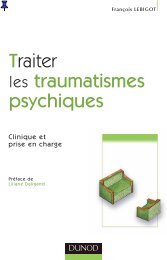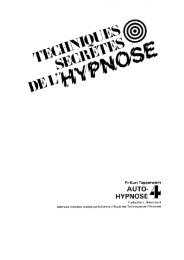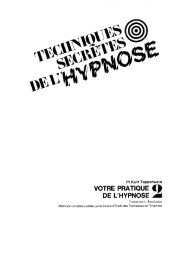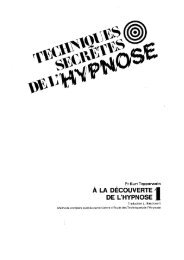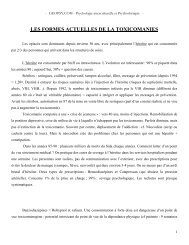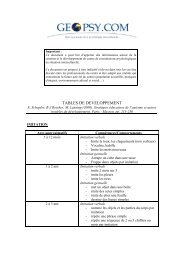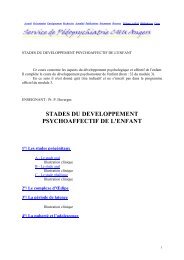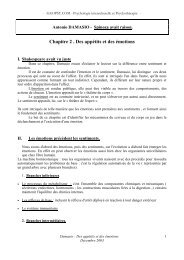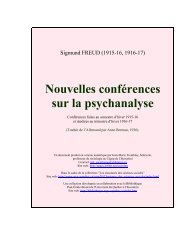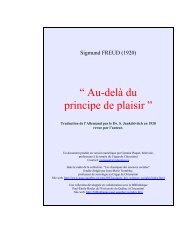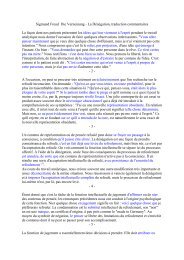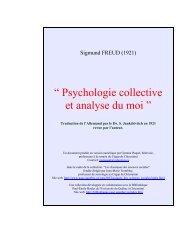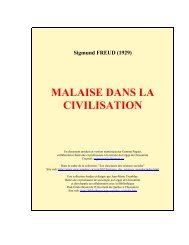psychologie de l'identité _ soi et le groupe
psychologie de l'identité _ soi et le groupe
psychologie de l'identité _ soi et le groupe
Create successful ePaper yourself
Turn your PDF publications into a flip-book with our unique Google optimized e-Paper software.
32 À LA RECHERCHE DE L’IDENTITÉ<br />
À la suite <strong>de</strong>s travaux d’Erikson, mais aussi <strong>de</strong> ceux plus anciens d’A.<br />
Kardiner (1969) sur la « personnalité <strong>de</strong> base », el<strong>le</strong> a étudié <strong>le</strong>s mécanismes<br />
par <strong>le</strong>squels chaque culture tend à produire <strong>et</strong> à transm<strong>et</strong>tre <strong>de</strong>s modè<strong>le</strong>s<br />
i<strong>de</strong>ntitaires <strong>et</strong> <strong>de</strong>s types <strong>de</strong> personnalité. On peut citer dans c<strong>et</strong>te orientation<br />
la recherche d’Erikson lui-même sur l’enfance dans différentes cultures<br />
(1960), cel<strong>le</strong> <strong>de</strong> M. Mead, notamment sur l’ado<strong>le</strong>scence, cel<strong>le</strong> d’E. Fromm<br />
sur <strong>le</strong> « caractère social » <strong>de</strong>s sociétés industrialisées, <strong>de</strong> B. B<strong>et</strong>telheim<br />
(1969) sur l’i<strong>de</strong>ntité <strong>de</strong>s jeunes <strong>de</strong>s kibboutz israéliens…<br />
En France, ce courant a été marqué par <strong>le</strong>s travaux <strong>de</strong> G. Devereux (1972)<br />
<strong>et</strong> par <strong>de</strong> nombreuses recherches sur <strong>le</strong>s problèmes d’i<strong>de</strong>ntité liés à l’immigration<br />
<strong>et</strong> aux contacts interculturels 1 .<br />
Toutes ces recherches ont mis en lumière <strong>le</strong>s processus d’interstructuration<br />
entre <strong>le</strong>s institutions qui fon<strong>de</strong>nt la culture <strong>et</strong> <strong>le</strong>s i<strong>de</strong>ntités individuel<strong>le</strong>s<br />
<strong>et</strong> col<strong>le</strong>ctives. El<strong>le</strong>s ont montré aussi que chaque culture est porteuse <strong>de</strong><br />
conceptions <strong>et</strong> <strong>de</strong> modè<strong>le</strong>s i<strong>de</strong>ntitaires différents.<br />
1.4.4 La perspective génétique<br />
La perspective génétique a inspiré aussi d’importants travaux sur l’émergence<br />
<strong>et</strong> <strong>le</strong> développement du sentiment d’i<strong>de</strong>ntité, tout particulièrement<br />
chez l’enfant <strong>et</strong> l’ado<strong>le</strong>scent. Dans ce domaine, H. Wallon a joué un rô<strong>le</strong> <strong>de</strong><br />
pionnier <strong>et</strong> a été l’inspirateur notamment en France <strong>de</strong> multip<strong>le</strong>s recherches<br />
comme cel<strong>le</strong>s <strong>de</strong> R. Zazzo, P. Malrieu, H. Rodriguez-Tomé, P. Tap...<br />
H. Wallon a mis notamment l’accent sur l’importance <strong>de</strong> la relation <strong>soi</strong>autrui<br />
dans la constitution <strong>de</strong> la conscience <strong>de</strong> <strong>soi</strong> <strong>et</strong> a essayé <strong>de</strong> fixer <strong>le</strong>s sta<strong>de</strong>s<br />
parcourus par l’enfant dans <strong>le</strong> processus <strong>de</strong> différenciation entre <strong>soi</strong> <strong>et</strong> autrui<br />
(cf. « Le rô<strong>le</strong> <strong>de</strong> “l’autre” dans la conscience du “moi” », 1959, <strong>et</strong> « La conscience<br />
<strong>de</strong> <strong>soi</strong> : ses <strong>de</strong>grés <strong>et</strong> ses mécanismes <strong>de</strong> trois mois à trois ans », 1932).<br />
Les recherches <strong>de</strong> R. Zazzo ont porté, entre autres, sur <strong>le</strong> « sta<strong>de</strong> du<br />
miroir », moment clé dans la reconnaissance <strong>de</strong> <strong>soi</strong>, <strong>et</strong> sur <strong>le</strong>s problèmes<br />
d’i<strong>de</strong>ntité chez <strong>le</strong>s jumeaux (1960). Cel<strong>le</strong>s <strong>de</strong> P. Malrieu <strong>et</strong> P. Tap sur<br />
l’« interstructuration » du suj<strong>et</strong> <strong>et</strong> <strong>de</strong>s institutions (Tap, 1988) <strong>et</strong> sur l’i<strong>de</strong>ntité<br />
masculine <strong>et</strong> féminine chez l’enfant (Tap, 1985).<br />
L’ado<strong>le</strong>scence a suscité, bien sûr, <strong>de</strong> multip<strong>le</strong>s étu<strong>de</strong>s parmi <strong>le</strong>squel<strong>le</strong>s on<br />
peut citer cel<strong>le</strong>s <strong>de</strong> B. Zazzo (1972), <strong>de</strong> H. Rodriguez-Tomé (1972, 1982) <strong>et</strong><br />
un riche ouvrage col<strong>le</strong>ctif (Kridis, 1990).<br />
R. L’Écuyer s’est efforcé <strong>de</strong> montrer que la quête d’i<strong>de</strong>ntité ne s’arrête pas<br />
à l’âge adulte <strong>et</strong> qu’el<strong>le</strong> continue à évoluer jusqu’à la vieil<strong>le</strong>sse (1978, 1980).<br />
1. Parmi <strong>le</strong>s travaux consacrés à la problématique i<strong>de</strong>ntitaire dans <strong>le</strong> contexte <strong>de</strong>s contacts interculturels<br />
on peut citer : I<strong>de</strong>ntités col<strong>le</strong>ctives <strong>et</strong> relations interculturel<strong>le</strong>s sous la dir. <strong>de</strong> G. Michaud,<br />
1978 ; S. Abou, Liban déraciné, 1978 ; J.-R. Ladmiral, E. M. Lipiansky, La Communication<br />
interculturel<strong>le</strong>, 1989 ; C. Camil<strong>le</strong>ri <strong>et</strong> al., Stratégies i<strong>de</strong>ntitaires, 1990 ; Chocs <strong>de</strong> cultures sous<br />
la direction <strong>de</strong> C. Camil<strong>le</strong>ri <strong>et</strong> M. Cohen-Emerique, 1989…




